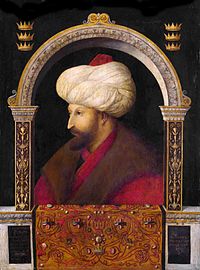Abu Qubail said from ‘Abd-Allaah ibn Amr ibn Ash, One time we were writing by the Prophet Muhammad and he was asked, Which is defeated first, Constantinople or Rome? He said It is Heraclius city that will be defeated first. The point is Constantinople. [H.R. Ahmad, Ad-Darimi, Al-Hakim]
The city of Constantinople will fall into Islamic hands. The leader who conquers him is the best leader and the army under his command is the best of the troops. [H.R. Ahmad ibn Hanbal al-Musnad 4/335]
Sultan Mehmed II (Ottoman Turkish): محمد ثانى Meḥmed-i sānī, Turkish language: II. Mehmet, also known as el-Fatih (الفاتح ), “the Conqueror”, in Usmani Turkish, or, Fatih Sultan Mehmet in Turkish; 30 March 1432 (3 May 1481) was an Ottoman Turkish sultan who conquered the Eastern Roman Empire. Has expertise in army, science, mathematics & mastered 6 languages when he was 21 years old. A great leader, choose a match, and humility after Sultan Salahuddin Al-Ayyubi (Islamic hero in the Crusades) and Sultan Saifuddin Mahmud Al-Qutuz (Islamic hero in the war in Ain Jalut against the Mongol army)
His success in conquering Constantinople left many comrades and opponents in awe of his leadership and his tactics and warfare tactics that were said to predate his time as well as his military selection methods. He is the protégé of Shaykh Syamsuddin who is still a descendant of Abu Bakr al-Siddiq.
It was also he who changed the name of Constantinople to Islambol (Islam in its entirety). It has now been changed by Mustafa Kemal Ataturk to Istanbul. To commemorate his service, the Al Fatih Mosque has been built next to his tomb.
It is said that Sultan Muhammad Al Fatih’s army has never left the mandatory prayer since baligh(puberty) & half of them have not left solat tahajud since baligh(puberty). Only Sultan Muhammad Al Fatih has never left the obligatory prayer, tahajud & rawatib from puberty until the time of his death.
Sultan Muhammad II or Mehmed Al-Fatih
The Roman Empire was split in two, Roman Catholics in the Vatican and Orthodox Greeks in Byzantium or Constantinople in what is now Istanbul. The split was the result of church conflict although the world still recognizes both as the center of civilization. Constantine The Great chose the city in the Bosphorus strait as its capital, strategically located on the borders of Europe and Asia, both on land as one of the Silk Road and in the sea between the Mediterranean and the Black Sea and considered the best point as the cultural center of the world, at least in geopolitical conditions at the time.
Those who sought the city to be overrun included the Gothics, Avars, Persians, Bulgars, Russians, Khazars, Arab-Muslims, and Crusaders although the original mission was to take control of Jerusalem. Arab-Muslims are encouraged to want to control Byzantium not only because of its strategic value but also for its belief in the prophecy of the Prophet Muhammad through the hadith above.
Region of Constantinople
The first attempt was made by Muawiyah ibn Abu Sufyan in 668, but failed and one of the companions of the Prophet (s) was Abu Ayyub Al-Anshari Ra. Fall. Abu Ayyub had previously made a will if he died asking to be buried at the furthest point that Muslims could reach. And his companions managed to sneak in and bury him right next to the wall of Constantinople fortress in the Golden Horn region.
The next generation, from the Umayyad and Abbasids to Ottoman Turks during Murad II’s reign also failed to conquer Byzantium. One of Murad II’s wars in the Balkans was against Vlad Dracul, a violent and sadistic Crusader (Bram Stoker’s Dracula is inspired by this character). For 800 years failure struck until Sultan Murad II’s son Muhammad II ascended the throne of Ottoman Turkey.
Since Sultan Murad I, Ottoman Turkey was built with a sophisticated military, one of which was with the formation of special forces called Yanisari. With ottoman Turkish military forces moving around Byzantium until Constantine felt threatened, although the fortifications protecting even two layers of the entire city were very difficult to penetrate, Constantine also called for help to Rome, but the church conflict did not spawn many reinforcements.
Constantine XI Paleologus
On Friday, April 6, 1453, Muhammad II or also mentioned Mehmed with his teacher, Sheikh Aaq Syamsudin, and his right-hand man Halil Pasha and Zaghanos Pasha planned attacks on Byzantium from various corners of the city fortress. Armed with 150,000 thousand troops and cannons made by Urban new technology at that time Muhammad II sent a letter to Paleologus to enter Islam or surrender control of the city peacefully or war. Constantine Paleologus responded by defending the city with the help of Cardinal Isidor, Prince Orkhan, and Giovanni Giustiniani of Genoa.
The city with its 10m fortress is difficult to penetrate, other than on the outer side of the fortress is also protected by a 7m trench. From the west through the artillery forces had to break into a two-layer fortress, from the south of Marmara the seamen had to face the Genoa sailors led by Giustiniani and from the east, the naval fleet had to enter the narrow strait of the Golden Horn which had been protected with a large chain until even a small warship could not pass.
For days to weeks, the Byzantine fortress could not break, even if it collapsed, making Constantine’s army gap able to defend the gap and quickly re-accumulate until it was closed. Another attempt was attempted by digging a tunnel under the fort, causing considerable panic in the city, but also failing. Until finally a stupid-sounding idea was done only overnight. One of the rather weak defenses is through the chained Golden Horn strait. The idea was eventually made, which was to move the ships by land to avoid the chain of barriers, only overnight and the 70s ships could enter the Golden Horn strait.
On May 29, after a day of rest Muhammad II’s war again attacked in total, accompanied by rain with three layers of troops, irregular in the first layer, Anatolian Army in the second, and final layer of Yanisari forces. Giustiniani had advised Constantine to retreat or surrender but Constantine remained consistent until his death in the war. Constantine reportedly took off his royal armor and fought with ordinary troops until his remains were never found. Giustiniani himself left the city with his Genoa army. Cardinal Isidor himself escaped by posing as a slave through Galata, and Prince Orkhan died in battle.
Constantinople had fallen, the inhabitants of the city flocked to Hagia Sophia, and Sultan Muhammad II gave refuge to all the inhabitants, anyone, whether Muslim, Jewish, or Christian. Hagia Sophia was eventually used as a mosque and other churches remained as it functioned for its adherents.
Tolerance is enforced, anyone can live and make a living in the city. The Sultan then rebuilt the city, built schools especially schools for the administrative benefit of the city for free, anyone could study, no difference to religion, build markets, build housing, even free houses to migrants willing to live and make a living in the ruins of the Byzantine city. Eventually, the city was transformed into Istanbul, and the search for Abu Ayyub’s tomb was carried out until it was discovered and preserved. And now the magnificent Hagia Sophia is transformed into a museum.
















